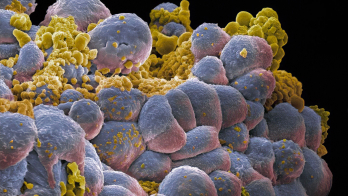
Image credit: Fermilab.
After more than a year of upgrades, Fermilab’s revamped accelerator complex is ready to send beam to its suite of fixed-target experiments, which now includes the new NOvA neutrino detector in northern Minnesota, 810 km north of the laboratory.
On 30 July, a beam of protons passed through the main injector for the first time since April 2012. With a circumference of 3.3 km, this synchrotron is the final stage of acceleration in the Fermilab accelerator complex, propelling protons from 8 to 120 GeV. Prior to the shutdown, the machine achieved a beam power of about 350 MW. The shutdown work paves the way to increase this to 700 MW.
The majority of this beam power from the main injector will be used to make neutrinos for the NOvA, MINOS and Minerva experiments. The first neutrinos were delivered on 4 September. A smaller fraction of the proton beam will go to the SeaQuest experiment and Fermilab’s Test Beam Facility. In the future, the main injector will also provide beam for the planned Muon g-2 and Mu2e experiments and the Long-Baseline Neutrino Experiment.
Following the revamp, Fermilab’s chain of accelerators begins with a new ion source and radio-frequency quadrupole (RFQ) to create a beam of negatively charged hydrogen ions, which are accelerated by the RFQ to an energy of 750 keV. The ions then enter the linac, which accelerates the particles to 400 MeV and sends them into the booster, where the particles pass through a foil that strips off the electrons and yields a proton beam. The upgraded booster, which accelerates protons to 8 GeV, now features solid-state RF stations and a few refurbished RF cavities. Once all of the RF cavities have been refurbished – in about two years from now – it will be able to operate at a repetition rate of up to 15 Hz. This work is part of the laboratory’s Proton Improvement Plan.
A major component of the upgraded accelerator complex is the revamped Recycler storage ring, which will play a major role in achieving higher beam power in the main injector. In the past, the Recycler stored 8 GeV antiprotons for the Tevatron collider. The Recycler is now being used for slip-stacking 8 GeV protons and as a result the main injector can deliver beam to Fermilab’s neutrino experiments every 1.3 s. Previously, it could send beam every 2.2 s only.








